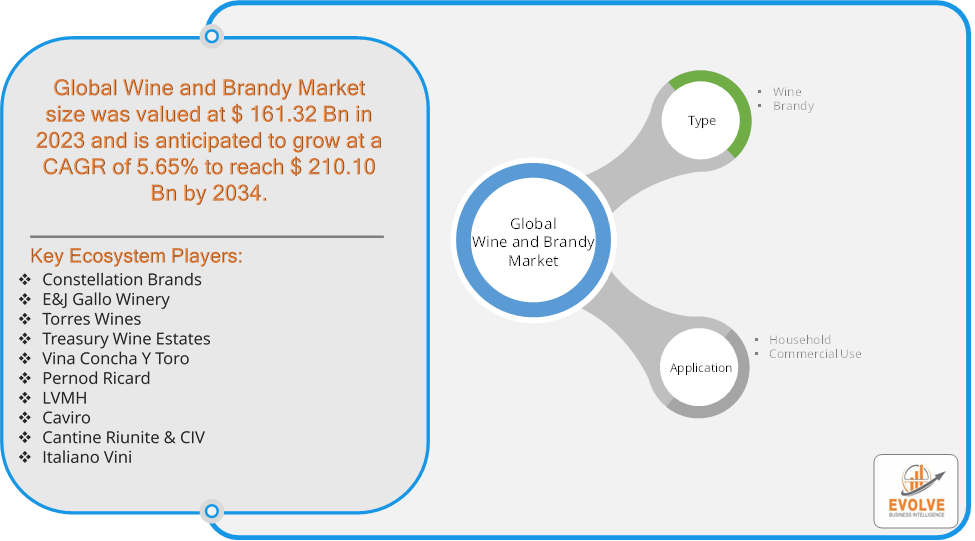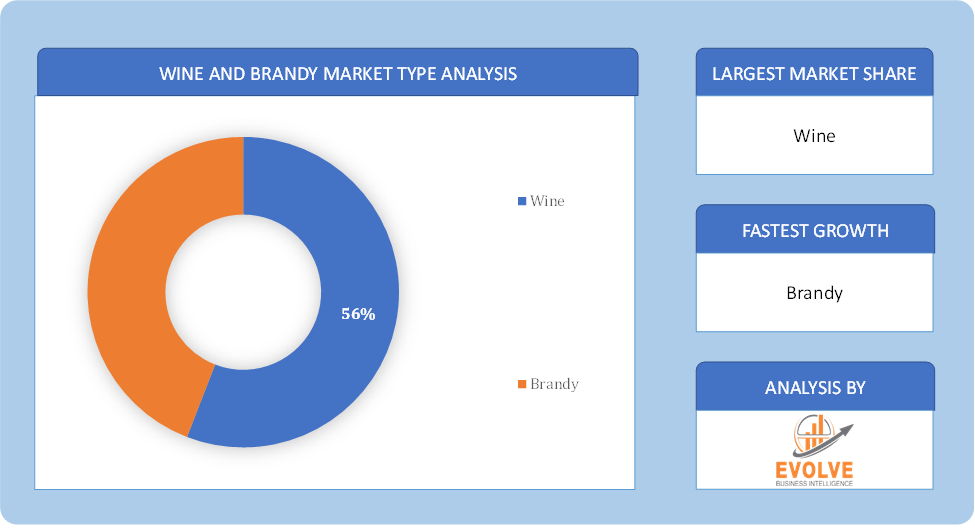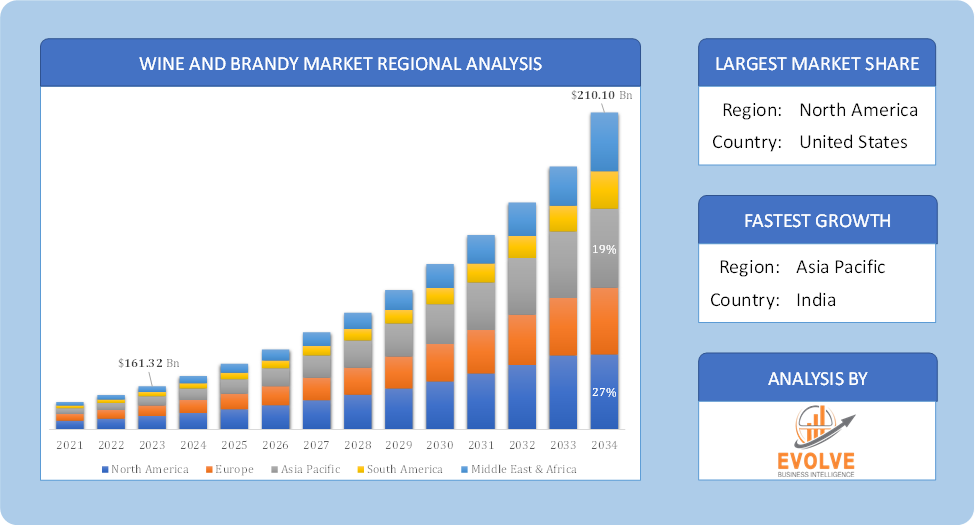Wine and Brandy Market Overview
The Wine and Brandy Market size accounted for USD 161.32 Billion in 2023 and is estimated to account for 170.52 Billion in 2024. The Market is expected to reach USD 210.10 Billion by 2034 growing at a compound annual growth rate (CAGR) of 5.65% from 2024 to 2034. The global wine and brandy market encompasses the production, distribution, and consumption of wine and brandy worldwide. Wine is an alcoholic beverage produced by fermenting grape juice, while brandy is a distilled alcoholic beverage typically made from fermented fruit juice, often grapes.
The global wine and brandy market is a dynamic and growing industry, with opportunities for both established players and new entrants. The Global Wine and Brandy Market is shaped by evolving consumer preferences, regional traditions, and innovations in production and marketing strategies.
Global Wine and Brandy Market Synopsis
 Wine and Brandy Market Dynamics
Wine and Brandy Market Dynamics
The major factors that have impacted the growth of Wine and Brandy Market are as follows:
Drivers:
Ø Growing Demand for Premium and High-Quality Products
Consumers are increasingly seeking premium wines and brandies, with a focus on quality, heritage, and craftsmanship. This trend is especially prominent among affluent and discerning consumers who are willing to pay higher prices for superior products. The rise of small-batch, artisanal wine and brandy producers has also contributed to the premiumization trend, as consumers seek unique and exclusive products. E-commerce platforms and online wine retailers are making it easier for consumers to access a wide variety of wine and brandy products. The convenience of online shopping has increased sales, particularly in regions where traditional distribution channels are less developed.
Restraint:
- Perception of Fluctuating Prices of Raw Materials
The cost of grapes, water, fertilizers, and other key inputs is subject to fluctuations, which can impact the profitability of wine and brandy producers. Any increase in raw material prices can lead to higher production costs, which may need to be passed on to consumers in the form of higher product prices. Transportation issues, labor shortages, or disruptions in supply chains due to global events (such as pandemics) can also affect the availability and price of raw materials needed for wine and brandy production.
Opportunity:
⮚ Digital Transformation and E-commerce
The growing importance of e-commerce and digital marketing presents a major opportunity for wine and brandy producers to reach a global audience. Online platforms allow producers to offer a wider selection of products, implement direct-to-consumer (DTC) models, and enhance brand visibility. The rise of wine subscription services and curated delivery boxes provides an additional channel for producers to engage with consumers, particularly younger demographics who prefer the convenience of home delivery and personalized experiences.
Wine and Brandy Market Segment Overview
Based on Type, the market is segmented based on Wine and Brandy. The Wine segment dominant the market. Across many regions, consumers are gravitating toward higher-quality, premium wines, driven by increased knowledge of wine and the desire for luxury experiences. Growing awareness of health and wellness is influencing consumption patterns, with more consumers opting for organic, low-alcohol, and sulfite-free wines. This trend presents an opportunity for producers focusing on sustainable and healthy wine options.
By Application
Based on Application, the market segment has been divided into Household and Commercial Use. The Commercial Use segment dominant the market. The global hospitality industry is a key consumer of wine and brandy, especially in luxury hotels, fine dining restaurants, and bars. As tourism grows and business travel resumes post-pandemic, the demand for high-quality alcoholic beverages, including premium wine and brandy, increases.
Global Wine and Brandy Market Regional Analysis
Based on region, the global Wine and Brandy Market has been divided into North America, Europe, Asia-Pacific, the Middle East & Africa, and Latin America. North America is projected to dominate the use of the Wine and Brandy Market followed by the Asia-Pacific and Europe regions.
 Global Wine and Brandy North America Market
Global Wine and Brandy North America Market
North America holds a dominant position in the Wine and Brandy Market. The U.S. is one of the largest wine markets globally, driven by growing demand for premium wines, particularly from California, Oregon, and Washington. Napa Valley and Sonoma are key wine-producing regions and consumers in North America, particularly millennials and Gen Z, are driving trends toward organic, sustainable, and low-alcohol wines. The demand for craft spirits is also boosting the premium brandy segment.
Global Wine and Brandy Asia-Pacific Market
The Asia-Pacific region has indeed emerged as the fastest-growing market for the Wine and Brandy Market industry. Asia-Pacific is one of the fastest-growing markets for wine and brandy, with rising disposable incomes, urbanization, and changing lifestyles driving demand. China, Japan, South Korea, and India are key markets in the region and China has emerged as a significant market for both wine and brandy. The growing middle class and changing drinking habits have led to increased consumption of imported wines, with French and Australian wines being particularly popular. China is also a growing market for premium brandy, especially cognac.
Competitive Landscape
The global Wine and Brandy Market is highly competitive, with numerous players offering a wide range of software solutions. The competitive landscape is characterized by the presence of established companies, as well as emerging startups and niche players. To increase their market position and attract a wide consumer base, the businesses are employing various strategies, such as product launches, and strategic alliances.
Prominent Players:
- Constellation Brands
- E&J Gallo Winery
- Torres Wines
- Treasury Wine Estates
- Vina Concha Y Toro
- Pernod Ricard
- LVMH
- Caviro
- Cantine Riunite & CIV
- Italiano Vini
Key Development
In May 2022, Accolade Wines launched zero-alcohol wine collection named ‘Called &Then,’ made using the company’s de-alcoholizing technique named ‘Zero Tech X technology.
In July 2021, E. & J. Gallo Winery partnered with Randall Grahm to release ‘The Language of Yes’, which is made from grapes varieties in California’s diverse Central Coast AVA.
Scope of the Report
Global Wine and Brandy Market, by Type
- Wine
- Brandy
Global Wine and Brandy Market, by Application
- Household
- Commercial Use
Global Wine and Brandy Market, by Region
- North America
- US
- Canada
- Mexico
- Europe
- UK
- Germany
- France
- Italy
- Spain
- Benelux
- Nordic
- Rest of Europe
- Asia Pacific
- China
- Japan
- South Korea
- Indonesia
- Austalia
- Malaysia
- India
- Rest of Asia Pacific
- South America
- Brazil
- Argentina
- Rest of South America
- Middle East & Africa
- Saudi Arabia
- UAE
- Egypt
- South Africa
- Rest of Middle East & Africa
| Parameters | Indicators |
|---|---|
| Market Size | 2034: USD 210.10 Billion |
| CAGR (2024-2034) | 5.65% |
| Base year | 2022 |
| Forecast Period | 2024-2034 |
| Historical Data | 2021 (2017 to 2020 On Demand) |
| Report Coverage | Revenue Forecast, Competitive Landscape, Growth Factors, and Trends |
| Key Segmentations | Type, Application |
| Geographies Covered | North America, Europe, Asia-Pacific, South America, Middle East, Africa |
| Key Vendors | Constellation Brands, E&J Gallo Winery, Torres Wines, Treasury Wine Estates, Vina Concha Y Toro, Pernod Ricard, LVMH, Caviro, Cantine Riunite & CIV and Italiano Vini. |
| Key Market Opportunities | · Digital Transformation and E-commerce |
| Key Market Drivers | · Growing Demand for Premium and High-Quality Products
· Rise of Online Sales and E-commerce |
REPORT CONTENT BRIEF:
- High-level analysis of the current and future Wine and Brandy Market trends and opportunities
- Detailed analysis of current market drivers, restraining factors, and opportunities in the future
- Wine and Brandy Market historical market size for the year 2021, and forecast from 2023 to 2033
- Wine and Brandy Market share analysis at each product level
- Competitor analysis with detailed insight into its product segment, Government & Defense strength, and strategies adopted.
- Identifies key strategies adopted including product launches and developments, mergers and acquisitions, joint ventures, collaborations, and partnerships as well as funding taken and investment done, among others.
- To identify and understand the various factors involved in the global Wine and Brandy Market affected by the pandemic
- To provide a detailed insight into the major companies operating in the market. The profiling will include the Government & Defense health of the company’s past 2-3 years with segmental and regional revenue breakup, product offering, recent developments, SWOT analysis, and key strategies.










